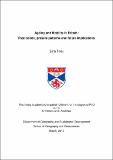Files in this item
Ageing and mobility in Britain : past trends, present patterns and future implications
Item metadata
| dc.contributor.advisor | Houston, Donald | |
| dc.contributor.author | Tilley, Sara | |
| dc.coverage.spatial | 284 | en_US |
| dc.date.accessioned | 2014-02-26T16:39:47Z | |
| dc.date.available | 2014-02-26T16:39:47Z | |
| dc.date.issued | 2013 | |
| dc.identifier.uri | https://hdl.handle.net/10023/4471 | |
| dc.description.abstract | Over the next decade the ‘Baby Boomer’ cohort will increasingly contribute to the proportion of those aged 60 and over in Britain. The issue of how the mobility of older people has changed for different cohort groups has not been considered in a historical context. Ryder (1965) argued that cohort groups could be important in determining behaviour as have other social structural factors, such as socioeconomic status. This thesis merges the disciplines of transport geography and population studies using a novel approach of cohort analysis, which has not been used widely for studying mobility trends. Using National Travel Survey data from 1995-2008, the mobility trends of older people in Britain are explored by creating pseudo cohorts. Pseudo cohorts are artificially created datasets which are constructed from using repeated cross-sectional data (McIntosh, 2005, Uren, 2006). This technique can differentiate ‘age’, ‘period’ and ‘cohort’ effects in mobility trends. Age effects are differences in behaviour between age groups i.e. changes in mobility associated with age itself. Period effects relate to changes in behaviour in all age groups over a period of time. Cohort effects are those associated with behaviour common to particular groups born around the same time (Glenn, 2005, Yang, 2007). The influence of the Scottish concessionary travel policy on the mobility of older people at the aggregate level is also considered using Scottish Household Survey data from 1999-2008. This policy is very blunt and based on assumptions about older age. As cohorts differ, these assumptions may no longer hold and therefore the policy may not be effective. This thesis argues, using a longitudinal demographic perspective, that structural effects shape mobility of cohorts differently over time. The findings reveal although mobility amongst older people is rising in general, there would actually be declining mobility were it not for the Boomer cohort. Amongst younger cohorts mobility is lower. The analysis also shows that women travel further than men, a fundamental break with the past, specific to this generation. This thesis illustrates the importance of cohort membership in explaining mobility change. | en_US |
| dc.language.iso | en | en_US |
| dc.publisher | University of St Andrews | en |
| dc.subject.lcc | HQ1063.5T5 | |
| dc.subject.lcsh | Older people--Transportation--Great Britain--Longitudinal studies | en_US |
| dc.subject.lcsh | Older people--Travel--Great Britain--Longitudinal studies | en_US |
| dc.subject.lcsh | Older people--Government policy--Great Britain--Longitudinal studies | en_US |
| dc.subject.lcsh | Older people--Orientation and mobility--Great Britain--Longitudinal studies | en_US |
| dc.subject.lcsh | Great Britain--Population--Longitudinal studies | en_US |
| dc.title | Ageing and mobility in Britain : past trends, present patterns and future implications | en_US |
| dc.type | Thesis | en_US |
| dc.contributor.sponsor | Economic and Social Research Council (ESRC) | en_US |
| dc.type.qualificationlevel | Doctoral | en_US |
| dc.type.qualificationname | PhD Doctor of Philosophy | en_US |
| dc.publisher.institution | The University of St Andrews | en_US |
This item appears in the following Collection(s)
Items in the St Andrews Research Repository are protected by copyright, with all rights reserved, unless otherwise indicated.

